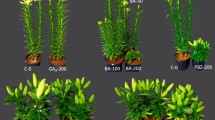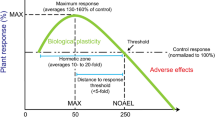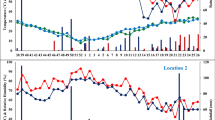Abstract
Tulip (Tulipa gesneriana L.) is a fascinating bulbous cut flower, and also used for potting, bedding, and border purpose. However, under the sub-tropical climatic conditions, quality tulip flower production is severely affected by its non-uniform bulb sprouting, lack or erratic flowering, small flower stalk, and short vase life. Hence, this study was performed to evaluate the potential of gibberellic acid (GA3) on sprouting, vegetative growth, flowering, flower quality, and vase life, including different bulb characteristics of ‘Ad-Rem’ tulip. Tulip bulbs were dipped in aqueous solution of different GA3 concentrations (0, 50, 75, 100, 125, and 150 mg L-1) for 30 min with Tween-20 (0.01%) as a surfactant. Tulip bulbs treated with 100 mg·L-1 GA3 sprouted in significantly less number of days, exhibited higher sprouting percentage, more plant height, leaf area, leaf chlorophyll, photosynthesis rate, flower stalk length, stalk diameter, and fresh and dry flower stalk weight. Moreover, 100 mg·L-1 GA3 application also decreased overall flower emergence time, increased flower size, produced attractive, glowing, and sturdy flowers with increased quality, and extended the vase life of ‘Ad-Rem’ tulip flowers up to 2.9-folds. However, 150 mg·L-1 GA3 application exhibited better results regarding daughter bulblets per clump with a subsequent increase in bulb diameter, and weight compared to other treatments. Additionally, significant correlation was also found among different growth, flower, and bulb characteristics of GA3-treated tulip plants. Hence, 100-150 mg·L-1 pre-planting exogenous application of GA3 may be effective for quality tulip production under the sub-tropical climatic conditions.
Similar content being viewed by others
References
Abou-Taleb, N.S. and A.M. Kandeel. 2001. Effect of fertilization level and GA application on growth, flowering, bulb productivity and chemical composition of Iris tingitana cv. Wedgewood. Arab Univ. J. Agric. Sci. 9:803–824.
Al-Khassawneh, N.M., N.S. Karam, and R.A. Shibli. 2006. Growth and flowering of black iris (Iris nigricans Dinsm.) following treatment with plant growth regulators. Sci. Hort. 107:187–193.
Baskaran, V. and R.L. Misra. 2007. Effect of plant growth regulators on growth and flowering of gladiolus. Ind. J. Hort. 64:479–482.
Carleton, A.F. and W.H. Foote. 1965. A comparison of methods for estimating total leaf area of barley plants. Crop Sci. 5:602–603.
De Hertogh, A.A. and M. Le Nard. 1993. The physiology of flower bulbs. Elsevier Science Publishers, The Netherlands.
Delvadia, D.V., T.R. Ahlawat, and B.J. Meena. 2009. Effect of different GA3 concentration and frequency on growth, flowering and yield in gaillardia (Gaillardia pulchella Foug.) cv. Lorenziana. J. Hort. Sci. 4:81–84.
De Mello, A.M., N.A. Streck, E.E. Blankenship, and E.T. Paparozzi. 2009. Gibberellic acid promotes seed germination in Penstemon digitalis cv. Husker Red. HortScience 44:870–873.
Dennis, D.J., J. Doreen, and T. Ohteki. 1994. Effect of a gibberellic acid ‘quick-dip’ and storage on the yield and quality of blooms from hybrid Zantedeschia tubers. Sci. Hort. 57:133–142.
Ducic, T., I. Liric-Rajlic, A. Mitrovic, and K. Radotic. 2003. Activities of antioxidant systems in Chenopodium rubrum L. seed germination. Biol. Plant. 47:527–533.
El-Naggar, A., H.A.A.M. El-Naggar, and N.M. Ismaiel. 2009. Effect of phosphorus application and gibberellic acid on the growth and flower quality of (Dianthus caryophyllus L.). Amer-Eur. J. Agri. Environ. Sci. 6:400–410.
Emami, H., M. Saeidnia, A. Hatamzadeh, D. Bakhshi, and E. Ghorbani. 2011. The effect of gibberellic acid and benzyladenine in growth and flowering of Lily (Lilium longiflorum). Advan. Environ. Biol. 5:1606–1611.
Geng, X.M., A. Sato, H. Okubo, and M. Saniewski. 2007. Changes in carbohydrate and ABA content during GA-induced growth of non-cooled tulip bulbs. J. Facul. Agri. Kyushu. Univ. 52:321–324.
Ghorbanli, M., S.H. Kaveh, and F.M. Sepehr. 1999. Effects of cadmium and gibberellin on growth and photosynthesis of Glycine max. Photosynthetica 17:627–631.
Hartmann, H.T., D.E. Kester, and E.T. Devies. 1989. Plant propagation, principles and practices. Englewood Cliffs, NJ, Prentice-Hall, Englewood Cliffs, NJ, USA.
Hassanpouraghdam, M.B., B. Hajisamadiasl, and A. Khalighi. 2011. Gibberellic acid foliar application influences growth, volatile oil and some physiological characteristics of lavender (Lavandula officinalis Chaix.). Rom. Biotechnol. Lett. 16:6322–6327.
Hopkins, W.G. and N.P.A. Huner. 2004. Introduction of plant physiology. John Wiely and Sons, Inc., New York, USA.
Huttly, A.K. and A.L. Phillips. 1995. Gibberellins-regulated plant genes. Physiol. Plant. 95:310–317.
Jhon, A.Q. and Neelofar. 2006. Tulip, p. 1–72. In: S.K. Bhattacharjee (ed.). Bulbous ornamental and aquatic plants: Advances in ornamental horticulture, Vol. 3. Pointers Publishers, Jaipur, India.
Jordi, W., C.S. Pot, G.M. Stoopen, and A.H.C.M. Schapendonk. 1994. Effect of light and gibberellic acid on photosynthesis during leaf senescence of Alstroemeria cut flowers. Physiol. Plant. 90:293–298.
Karuna, S., A.K. Singh, and H.K. Singh. 2011. Effect of plant growth regulators on spike yield and bulb production of tuberose (Polianthus tuberosa Linn) Double. Plant Arch. 11:169–171.
Khan, F.U., F.A. Malik, F.A. Khan, and M.A.A.A. Siddique. 2007. Effect of plant growth regulators on growth, physiological behavior and flower quality of ‘Cassini’ tulip (Tulipa gesneriana). Ind. J. Agri. Sci. 77:695–697.
Komor, E. 2000. Source physiology and assimilate transport: The interaction of sucrose metabolism, starch storage and phloem export in source leaves and the effects on sugar status in phloem. Austr. J. Plant Physiol. 27:497–505.
Kucera, B., M.A. Cohn, and G.L. Metzger. 2005. Plant hormone interactions during seed dormancy release and germination. Seed Sci. Res. 15:281–307.
Kuiper, D. 1993. Sink strength: Established and regulated by plant growth regulators. Plant Cell Environ. 16:1025–1026.
Mahesh, K.S. and R.L. Misra. 1993. Effect of growth regulators on gladiolus. J. Ornament. Hort. 1:12–15.
Ouzounidou, G. and I. Ilias. 2005. Hormone-induced protection of sunflower photosynthetic apparatus against Cu toxicity. Biol. Plant. 49:223–228.
Ranwala, A.P., G. Legnani, M. Reitmeier, B.B. Stewart, and W.B. Miller. 2002. Efficiency of plant growth regulators as pre-plant bulb dips for height control in LA and oriental hybrid lilies. HortTechnology 12:426–431.
Rees, A.R. 1992. Ornamental Bulbs, corms and tubers. Redwood Pub., Melksham, United Kingdom.
Saniewski, M. and W.J. De Munk. 1981. Hormonal control of shoot elongation in tulips. Sci. Hort. 15:363–372.
Steel, R.G.D., J.H. Torrie, and D.A. Dicky. 1997. Principles and procedures of statistics. A Biometric Approach, McGraw Hill Book Co., New York.
Vieira, M.R.S., V. Citadini, G.P.P. Lima, A.V. Souza, and L.S. Alves. 2010. Use of gibberellin in floriculture. Afr. J. Biotechnol. 9:9118–9121.
Younis, A., M.Z.M. Bhatti, A. Riaz, U. Tariq, M. Hameed, M. Nadeem, and M. Ahsan. 2012. Effect of different types of mulching on growth and flowering of Freesia alba cv. Aurora. Pak. J. Agri. Sci. 49: 429–433.
Younis, A., S. Anjum, A. Riaz, M. Hameed, U. Tariq, and M. Ahsan. 2014. Production of quality dahlia (Dahlia variabilis cv. Redskin) flowers by efficient nutrients management. American-Eurasian J. Agri. Environ. Sci. 14:137–142.
Author information
Authors and Affiliations
Corresponding author
Rights and permissions
About this article
Cite this article
Ramzan, F., Younis, A., Riaz, A. et al. Pre-planting exogenous application of gibberellic acid influences sprouting, vegetative growth, flowering, and subsequent bulb characteristics of ‘Ad-Rem’ tulip. Hortic. Environ. Biotechnol. 55, 479–488 (2014). https://doi.org/10.1007/s13580-014-0113-7
Received:
Revised:
Accepted:
Published:
Issue Date:
DOI: https://doi.org/10.1007/s13580-014-0113-7




